Health Education Program: Hypertension in Australia - Analysis
VerifiedAdded on 2022/08/29
|12
|2912
|48
Essay
AI Summary
This essay presents a health education program designed to address hypertension, a significant health concern in Australia. The program is structured around key principles of health promotion, including the development of healthy public policy, the creation of a supportive environment, strengthening community action, fostering personal skills, and reorienting health services. The essay analyzes these principles in detail, proposing specific strategies such as strengthening collaboration among healthcare professionals, promoting community health awareness programs, and implementing effective food and beverage policies. It emphasizes the importance of addressing hypertension through population-based strategies and highlights the role of health education in empowering individuals with the knowledge and skills needed to manage and prevent the condition. The program also considers the effectiveness of the proposed interventions, suggesting methods for evaluation and assessment, such as monitoring patient records and gathering feedback. The essay concludes that a comprehensive approach, integrating policy changes, community engagement, and individual skill development, is essential for effectively tackling hypertension and improving public health outcomes in Australia.
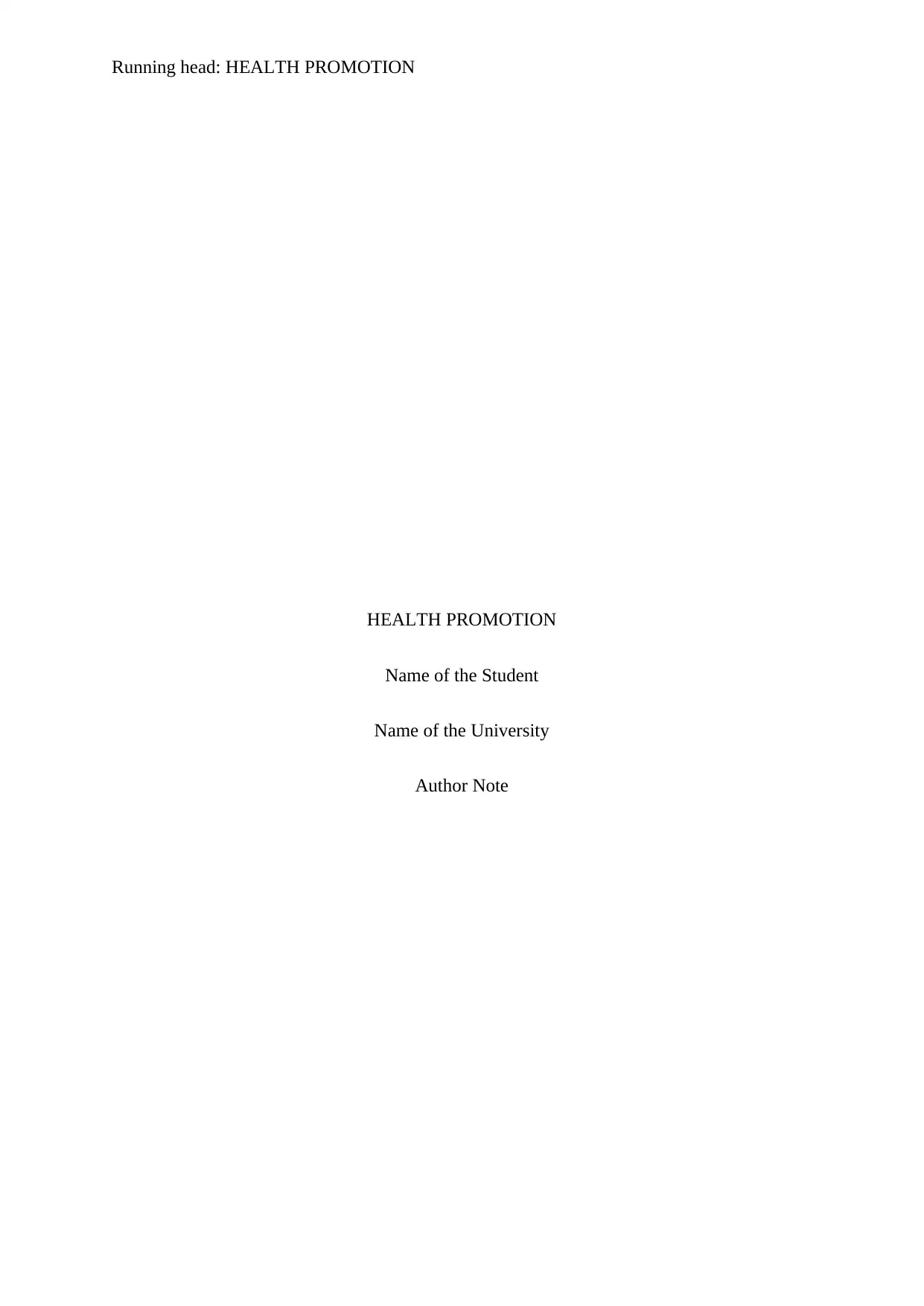
Running head: HEALTH PROMOTION
HEALTH PROMOTION
Name of the Student
Name of the University
Author Note
HEALTH PROMOTION
Name of the Student
Name of the University
Author Note
Paraphrase This Document
Need a fresh take? Get an instant paraphrase of this document with our AI Paraphraser
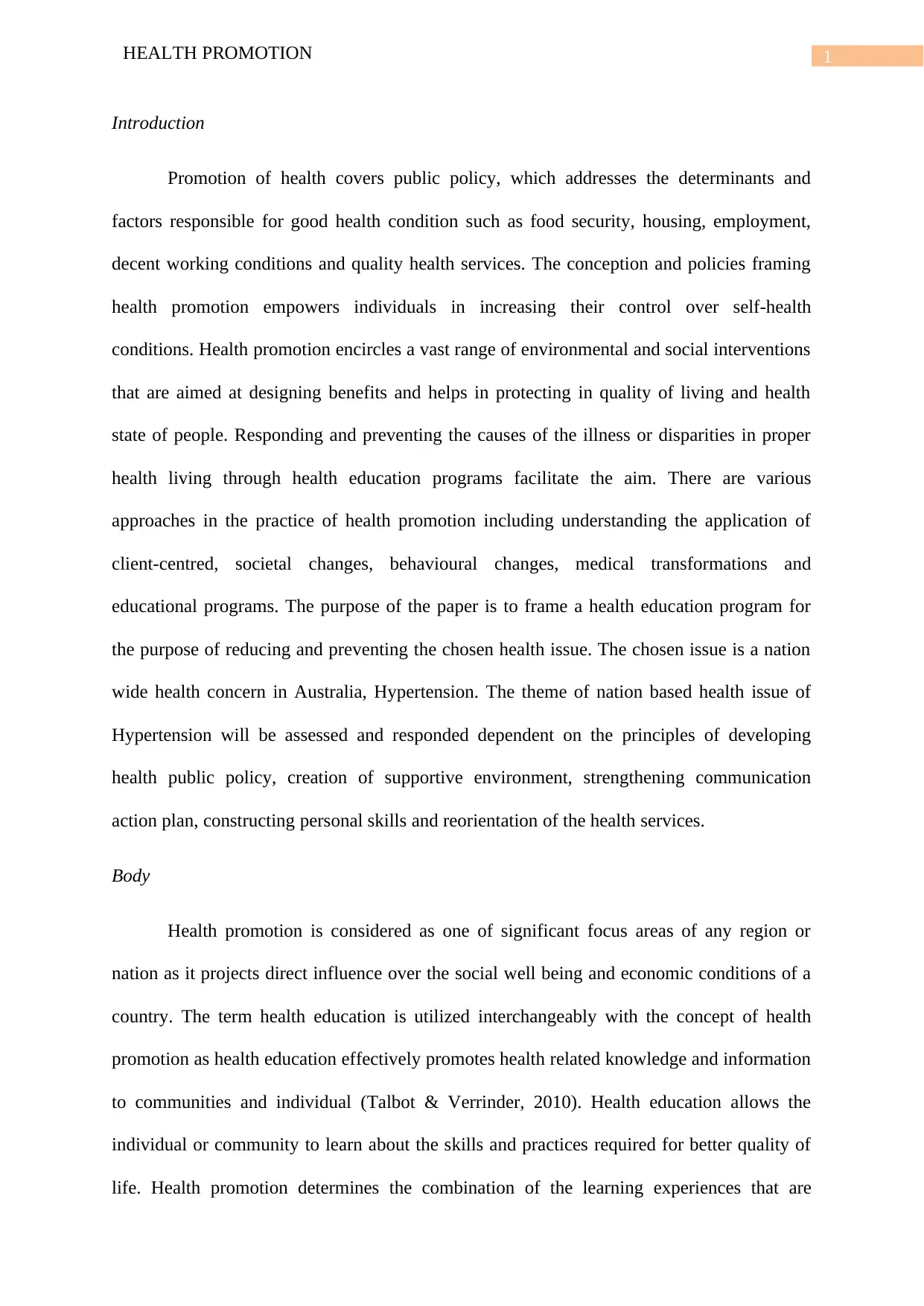
1HEALTH PROMOTION
Introduction
Promotion of health covers public policy, which addresses the determinants and
factors responsible for good health condition such as food security, housing, employment,
decent working conditions and quality health services. The conception and policies framing
health promotion empowers individuals in increasing their control over self-health
conditions. Health promotion encircles a vast range of environmental and social interventions
that are aimed at designing benefits and helps in protecting in quality of living and health
state of people. Responding and preventing the causes of the illness or disparities in proper
health living through health education programs facilitate the aim. There are various
approaches in the practice of health promotion including understanding the application of
client-centred, societal changes, behavioural changes, medical transformations and
educational programs. The purpose of the paper is to frame a health education program for
the purpose of reducing and preventing the chosen health issue. The chosen issue is a nation
wide health concern in Australia, Hypertension. The theme of nation based health issue of
Hypertension will be assessed and responded dependent on the principles of developing
health public policy, creation of supportive environment, strengthening communication
action plan, constructing personal skills and reorientation of the health services.
Body
Health promotion is considered as one of significant focus areas of any region or
nation as it projects direct influence over the social well being and economic conditions of a
country. The term health education is utilized interchangeably with the concept of health
promotion as health education effectively promotes health related knowledge and information
to communities and individual (Talbot & Verrinder, 2010). Health education allows the
individual or community to learn about the skills and practices required for better quality of
life. Health promotion determines the combination of the learning experiences that are
Introduction
Promotion of health covers public policy, which addresses the determinants and
factors responsible for good health condition such as food security, housing, employment,
decent working conditions and quality health services. The conception and policies framing
health promotion empowers individuals in increasing their control over self-health
conditions. Health promotion encircles a vast range of environmental and social interventions
that are aimed at designing benefits and helps in protecting in quality of living and health
state of people. Responding and preventing the causes of the illness or disparities in proper
health living through health education programs facilitate the aim. There are various
approaches in the practice of health promotion including understanding the application of
client-centred, societal changes, behavioural changes, medical transformations and
educational programs. The purpose of the paper is to frame a health education program for
the purpose of reducing and preventing the chosen health issue. The chosen issue is a nation
wide health concern in Australia, Hypertension. The theme of nation based health issue of
Hypertension will be assessed and responded dependent on the principles of developing
health public policy, creation of supportive environment, strengthening communication
action plan, constructing personal skills and reorientation of the health services.
Body
Health promotion is considered as one of significant focus areas of any region or
nation as it projects direct influence over the social well being and economic conditions of a
country. The term health education is utilized interchangeably with the concept of health
promotion as health education effectively promotes health related knowledge and information
to communities and individual (Talbot & Verrinder, 2010). Health education allows the
individual or community to learn about the skills and practices required for better quality of
life. Health promotion determines the combination of the learning experiences that are
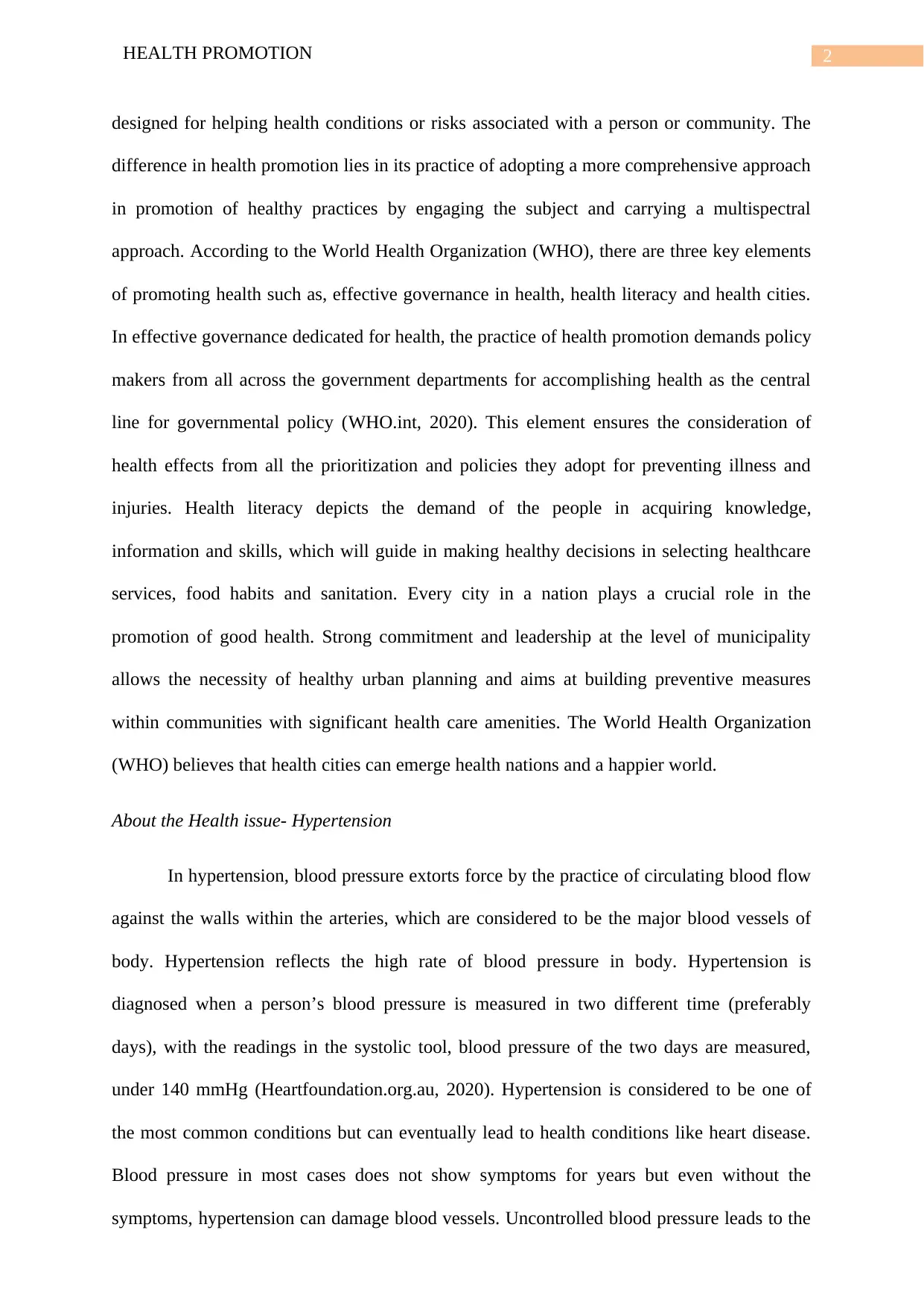
2HEALTH PROMOTION
designed for helping health conditions or risks associated with a person or community. The
difference in health promotion lies in its practice of adopting a more comprehensive approach
in promotion of healthy practices by engaging the subject and carrying a multispectral
approach. According to the World Health Organization (WHO), there are three key elements
of promoting health such as, effective governance in health, health literacy and health cities.
In effective governance dedicated for health, the practice of health promotion demands policy
makers from all across the government departments for accomplishing health as the central
line for governmental policy (WHO.int, 2020). This element ensures the consideration of
health effects from all the prioritization and policies they adopt for preventing illness and
injuries. Health literacy depicts the demand of the people in acquiring knowledge,
information and skills, which will guide in making healthy decisions in selecting healthcare
services, food habits and sanitation. Every city in a nation plays a crucial role in the
promotion of good health. Strong commitment and leadership at the level of municipality
allows the necessity of healthy urban planning and aims at building preventive measures
within communities with significant health care amenities. The World Health Organization
(WHO) believes that health cities can emerge health nations and a happier world.
About the Health issue- Hypertension
In hypertension, blood pressure extorts force by the practice of circulating blood flow
against the walls within the arteries, which are considered to be the major blood vessels of
body. Hypertension reflects the high rate of blood pressure in body. Hypertension is
diagnosed when a person’s blood pressure is measured in two different time (preferably
days), with the readings in the systolic tool, blood pressure of the two days are measured,
under 140 mmHg (Heartfoundation.org.au, 2020). Hypertension is considered to be one of
the most common conditions but can eventually lead to health conditions like heart disease.
Blood pressure in most cases does not show symptoms for years but even without the
symptoms, hypertension can damage blood vessels. Uncontrolled blood pressure leads to the
designed for helping health conditions or risks associated with a person or community. The
difference in health promotion lies in its practice of adopting a more comprehensive approach
in promotion of healthy practices by engaging the subject and carrying a multispectral
approach. According to the World Health Organization (WHO), there are three key elements
of promoting health such as, effective governance in health, health literacy and health cities.
In effective governance dedicated for health, the practice of health promotion demands policy
makers from all across the government departments for accomplishing health as the central
line for governmental policy (WHO.int, 2020). This element ensures the consideration of
health effects from all the prioritization and policies they adopt for preventing illness and
injuries. Health literacy depicts the demand of the people in acquiring knowledge,
information and skills, which will guide in making healthy decisions in selecting healthcare
services, food habits and sanitation. Every city in a nation plays a crucial role in the
promotion of good health. Strong commitment and leadership at the level of municipality
allows the necessity of healthy urban planning and aims at building preventive measures
within communities with significant health care amenities. The World Health Organization
(WHO) believes that health cities can emerge health nations and a happier world.
About the Health issue- Hypertension
In hypertension, blood pressure extorts force by the practice of circulating blood flow
against the walls within the arteries, which are considered to be the major blood vessels of
body. Hypertension reflects the high rate of blood pressure in body. Hypertension is
diagnosed when a person’s blood pressure is measured in two different time (preferably
days), with the readings in the systolic tool, blood pressure of the two days are measured,
under 140 mmHg (Heartfoundation.org.au, 2020). Hypertension is considered to be one of
the most common conditions but can eventually lead to health conditions like heart disease.
Blood pressure in most cases does not show symptoms for years but even without the
symptoms, hypertension can damage blood vessels. Uncontrolled blood pressure leads to the
⊘ This is a preview!⊘
Do you want full access?
Subscribe today to unlock all pages.

Trusted by 1+ million students worldwide
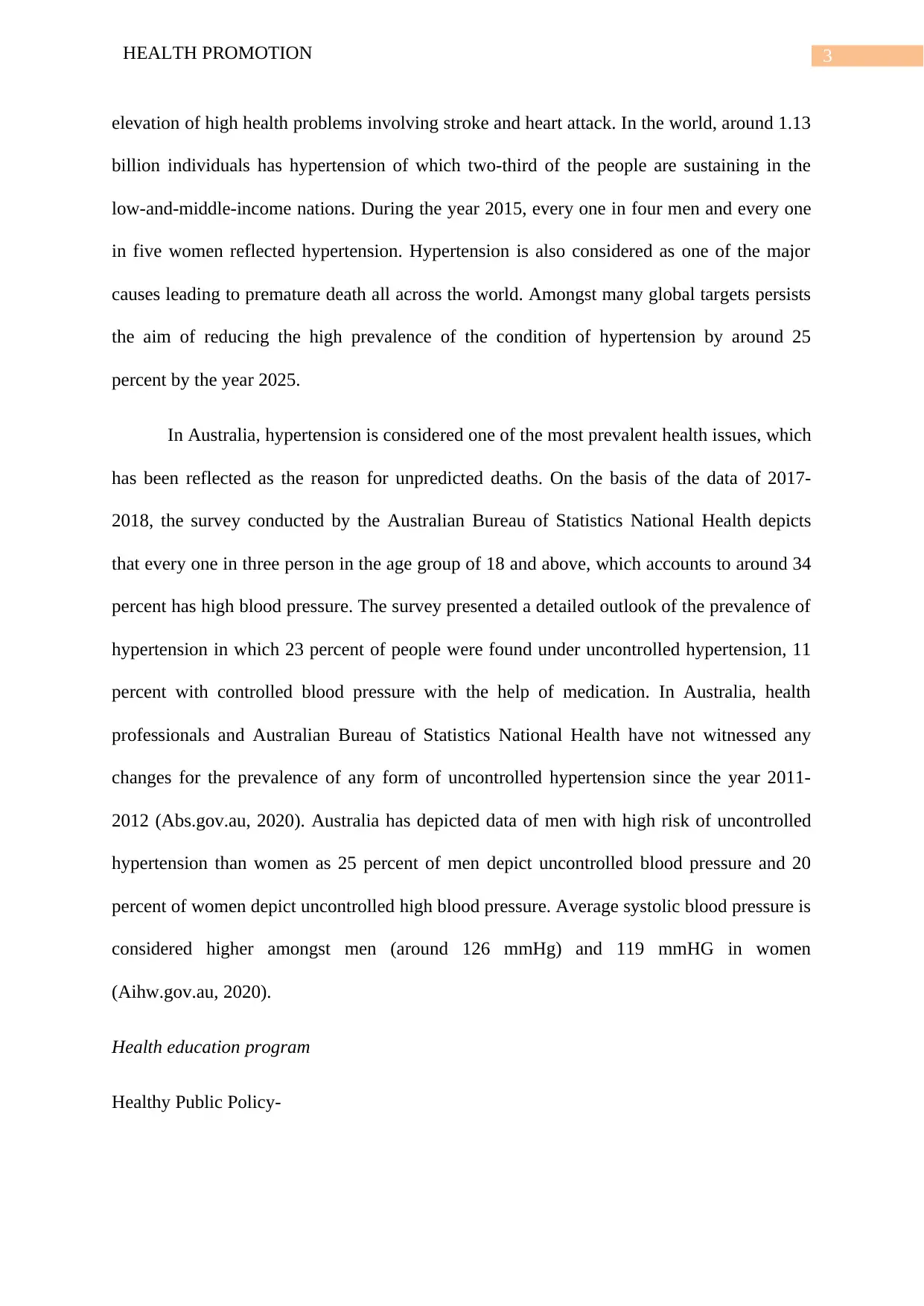
3HEALTH PROMOTION
elevation of high health problems involving stroke and heart attack. In the world, around 1.13
billion individuals has hypertension of which two-third of the people are sustaining in the
low-and-middle-income nations. During the year 2015, every one in four men and every one
in five women reflected hypertension. Hypertension is also considered as one of the major
causes leading to premature death all across the world. Amongst many global targets persists
the aim of reducing the high prevalence of the condition of hypertension by around 25
percent by the year 2025.
In Australia, hypertension is considered one of the most prevalent health issues, which
has been reflected as the reason for unpredicted deaths. On the basis of the data of 2017-
2018, the survey conducted by the Australian Bureau of Statistics National Health depicts
that every one in three person in the age group of 18 and above, which accounts to around 34
percent has high blood pressure. The survey presented a detailed outlook of the prevalence of
hypertension in which 23 percent of people were found under uncontrolled hypertension, 11
percent with controlled blood pressure with the help of medication. In Australia, health
professionals and Australian Bureau of Statistics National Health have not witnessed any
changes for the prevalence of any form of uncontrolled hypertension since the year 2011-
2012 (Abs.gov.au, 2020). Australia has depicted data of men with high risk of uncontrolled
hypertension than women as 25 percent of men depict uncontrolled blood pressure and 20
percent of women depict uncontrolled high blood pressure. Average systolic blood pressure is
considered higher amongst men (around 126 mmHg) and 119 mmHG in women
(Aihw.gov.au, 2020).
Health education program
Healthy Public Policy-
elevation of high health problems involving stroke and heart attack. In the world, around 1.13
billion individuals has hypertension of which two-third of the people are sustaining in the
low-and-middle-income nations. During the year 2015, every one in four men and every one
in five women reflected hypertension. Hypertension is also considered as one of the major
causes leading to premature death all across the world. Amongst many global targets persists
the aim of reducing the high prevalence of the condition of hypertension by around 25
percent by the year 2025.
In Australia, hypertension is considered one of the most prevalent health issues, which
has been reflected as the reason for unpredicted deaths. On the basis of the data of 2017-
2018, the survey conducted by the Australian Bureau of Statistics National Health depicts
that every one in three person in the age group of 18 and above, which accounts to around 34
percent has high blood pressure. The survey presented a detailed outlook of the prevalence of
hypertension in which 23 percent of people were found under uncontrolled hypertension, 11
percent with controlled blood pressure with the help of medication. In Australia, health
professionals and Australian Bureau of Statistics National Health have not witnessed any
changes for the prevalence of any form of uncontrolled hypertension since the year 2011-
2012 (Abs.gov.au, 2020). Australia has depicted data of men with high risk of uncontrolled
hypertension than women as 25 percent of men depict uncontrolled blood pressure and 20
percent of women depict uncontrolled high blood pressure. Average systolic blood pressure is
considered higher amongst men (around 126 mmHg) and 119 mmHG in women
(Aihw.gov.au, 2020).
Health education program
Healthy Public Policy-
Paraphrase This Document
Need a fresh take? Get an instant paraphrase of this document with our AI Paraphraser
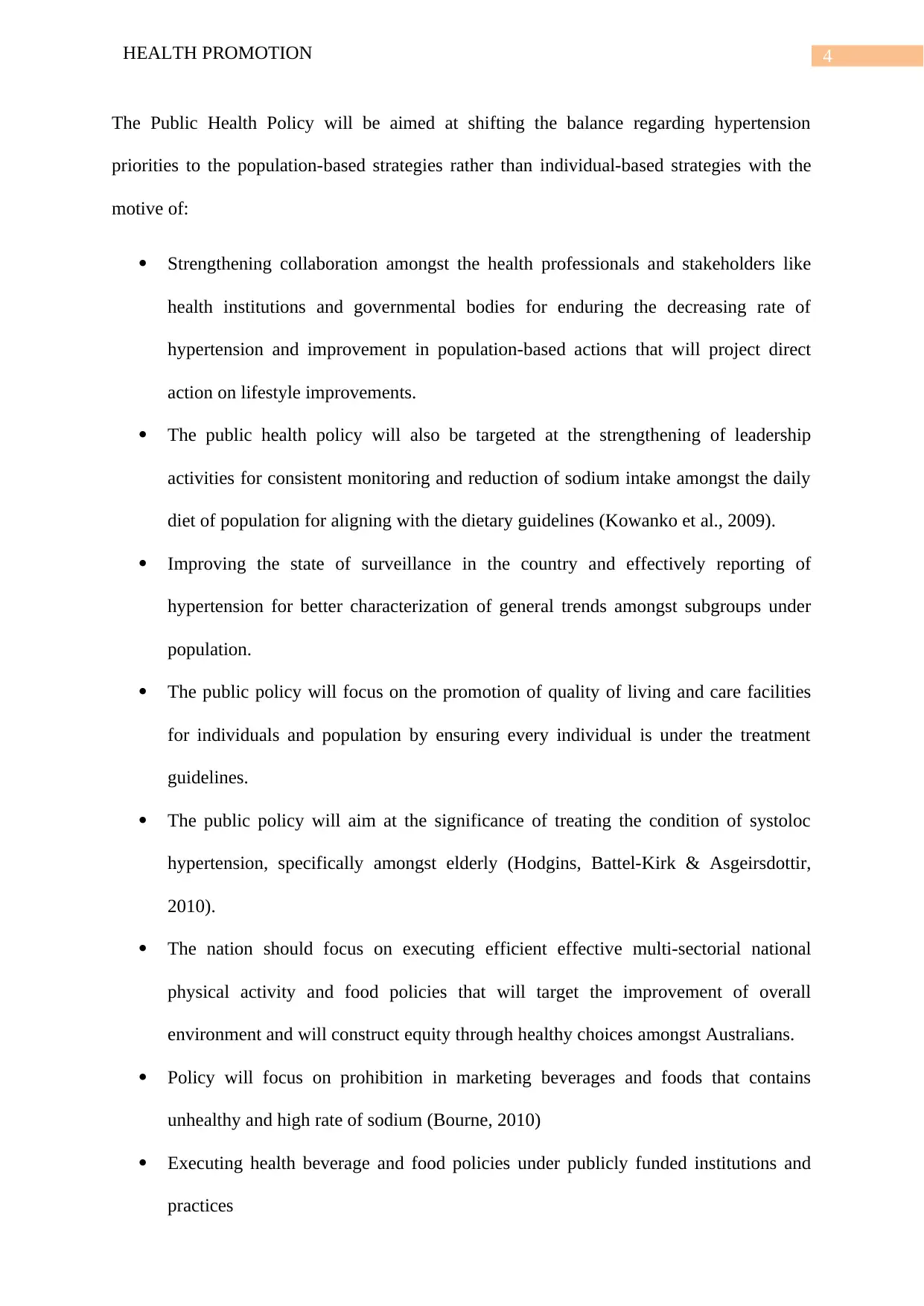
4HEALTH PROMOTION
The Public Health Policy will be aimed at shifting the balance regarding hypertension
priorities to the population-based strategies rather than individual-based strategies with the
motive of:
Strengthening collaboration amongst the health professionals and stakeholders like
health institutions and governmental bodies for enduring the decreasing rate of
hypertension and improvement in population-based actions that will project direct
action on lifestyle improvements.
The public health policy will also be targeted at the strengthening of leadership
activities for consistent monitoring and reduction of sodium intake amongst the daily
diet of population for aligning with the dietary guidelines (Kowanko et al., 2009).
Improving the state of surveillance in the country and effectively reporting of
hypertension for better characterization of general trends amongst subgroups under
population.
The public policy will focus on the promotion of quality of living and care facilities
for individuals and population by ensuring every individual is under the treatment
guidelines.
The public policy will aim at the significance of treating the condition of systoloc
hypertension, specifically amongst elderly (Hodgins, Battel-Kirk & Asgeirsdottir,
2010).
The nation should focus on executing efficient effective multi-sectorial national
physical activity and food policies that will target the improvement of overall
environment and will construct equity through healthy choices amongst Australians.
Policy will focus on prohibition in marketing beverages and foods that contains
unhealthy and high rate of sodium (Bourne, 2010)
Executing health beverage and food policies under publicly funded institutions and
practices
The Public Health Policy will be aimed at shifting the balance regarding hypertension
priorities to the population-based strategies rather than individual-based strategies with the
motive of:
Strengthening collaboration amongst the health professionals and stakeholders like
health institutions and governmental bodies for enduring the decreasing rate of
hypertension and improvement in population-based actions that will project direct
action on lifestyle improvements.
The public health policy will also be targeted at the strengthening of leadership
activities for consistent monitoring and reduction of sodium intake amongst the daily
diet of population for aligning with the dietary guidelines (Kowanko et al., 2009).
Improving the state of surveillance in the country and effectively reporting of
hypertension for better characterization of general trends amongst subgroups under
population.
The public policy will focus on the promotion of quality of living and care facilities
for individuals and population by ensuring every individual is under the treatment
guidelines.
The public policy will aim at the significance of treating the condition of systoloc
hypertension, specifically amongst elderly (Hodgins, Battel-Kirk & Asgeirsdottir,
2010).
The nation should focus on executing efficient effective multi-sectorial national
physical activity and food policies that will target the improvement of overall
environment and will construct equity through healthy choices amongst Australians.
Policy will focus on prohibition in marketing beverages and foods that contains
unhealthy and high rate of sodium (Bourne, 2010)
Executing health beverage and food policies under publicly funded institutions and
practices
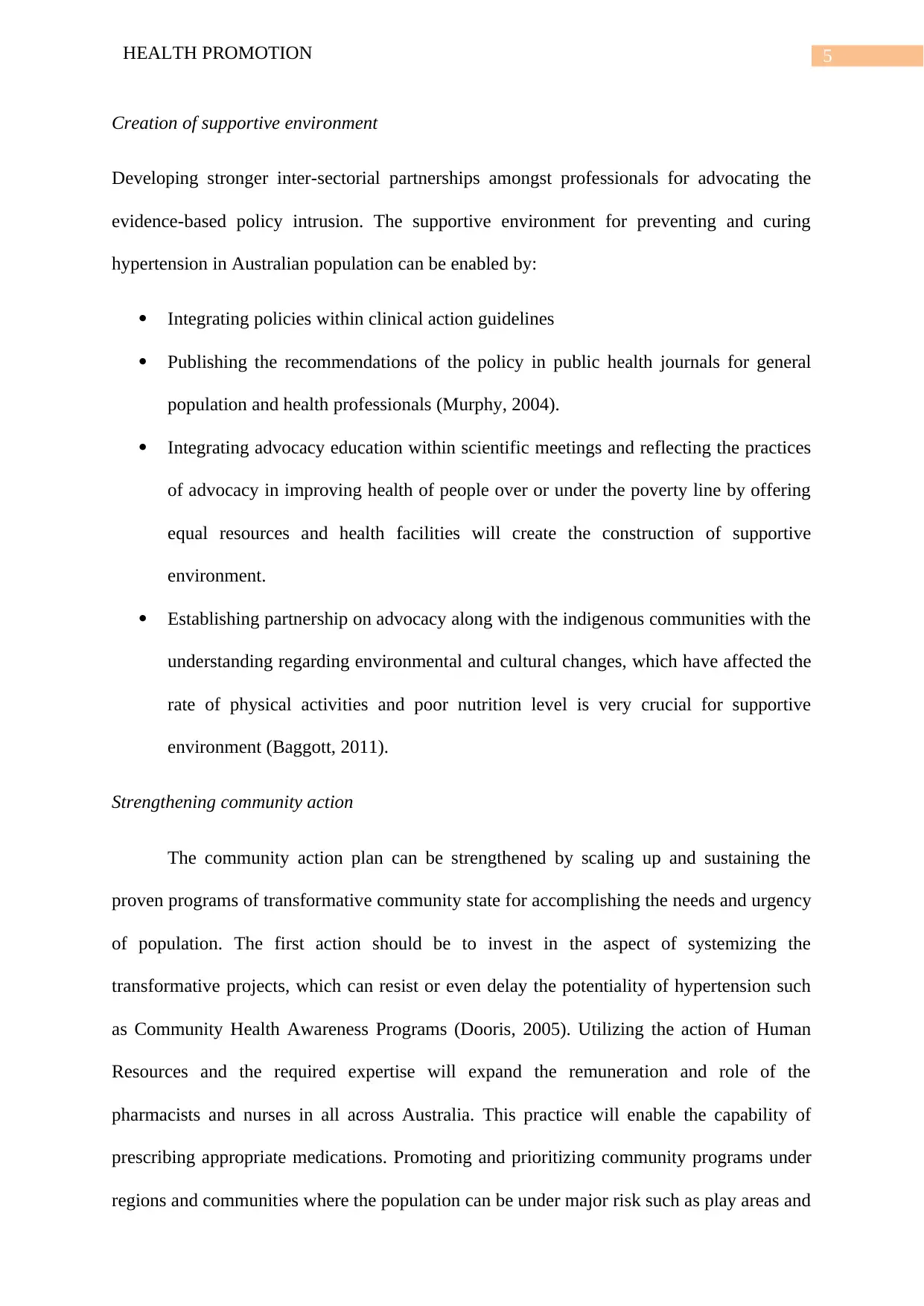
5HEALTH PROMOTION
Creation of supportive environment
Developing stronger inter-sectorial partnerships amongst professionals for advocating the
evidence-based policy intrusion. The supportive environment for preventing and curing
hypertension in Australian population can be enabled by:
Integrating policies within clinical action guidelines
Publishing the recommendations of the policy in public health journals for general
population and health professionals (Murphy, 2004).
Integrating advocacy education within scientific meetings and reflecting the practices
of advocacy in improving health of people over or under the poverty line by offering
equal resources and health facilities will create the construction of supportive
environment.
Establishing partnership on advocacy along with the indigenous communities with the
understanding regarding environmental and cultural changes, which have affected the
rate of physical activities and poor nutrition level is very crucial for supportive
environment (Baggott, 2011).
Strengthening community action
The community action plan can be strengthened by scaling up and sustaining the
proven programs of transformative community state for accomplishing the needs and urgency
of population. The first action should be to invest in the aspect of systemizing the
transformative projects, which can resist or even delay the potentiality of hypertension such
as Community Health Awareness Programs (Dooris, 2005). Utilizing the action of Human
Resources and the required expertise will expand the remuneration and role of the
pharmacists and nurses in all across Australia. This practice will enable the capability of
prescribing appropriate medications. Promoting and prioritizing community programs under
regions and communities where the population can be under major risk such as play areas and
Creation of supportive environment
Developing stronger inter-sectorial partnerships amongst professionals for advocating the
evidence-based policy intrusion. The supportive environment for preventing and curing
hypertension in Australian population can be enabled by:
Integrating policies within clinical action guidelines
Publishing the recommendations of the policy in public health journals for general
population and health professionals (Murphy, 2004).
Integrating advocacy education within scientific meetings and reflecting the practices
of advocacy in improving health of people over or under the poverty line by offering
equal resources and health facilities will create the construction of supportive
environment.
Establishing partnership on advocacy along with the indigenous communities with the
understanding regarding environmental and cultural changes, which have affected the
rate of physical activities and poor nutrition level is very crucial for supportive
environment (Baggott, 2011).
Strengthening community action
The community action plan can be strengthened by scaling up and sustaining the
proven programs of transformative community state for accomplishing the needs and urgency
of population. The first action should be to invest in the aspect of systemizing the
transformative projects, which can resist or even delay the potentiality of hypertension such
as Community Health Awareness Programs (Dooris, 2005). Utilizing the action of Human
Resources and the required expertise will expand the remuneration and role of the
pharmacists and nurses in all across Australia. This practice will enable the capability of
prescribing appropriate medications. Promoting and prioritizing community programs under
regions and communities where the population can be under major risk such as play areas and
⊘ This is a preview!⊘
Do you want full access?
Subscribe today to unlock all pages.

Trusted by 1+ million students worldwide
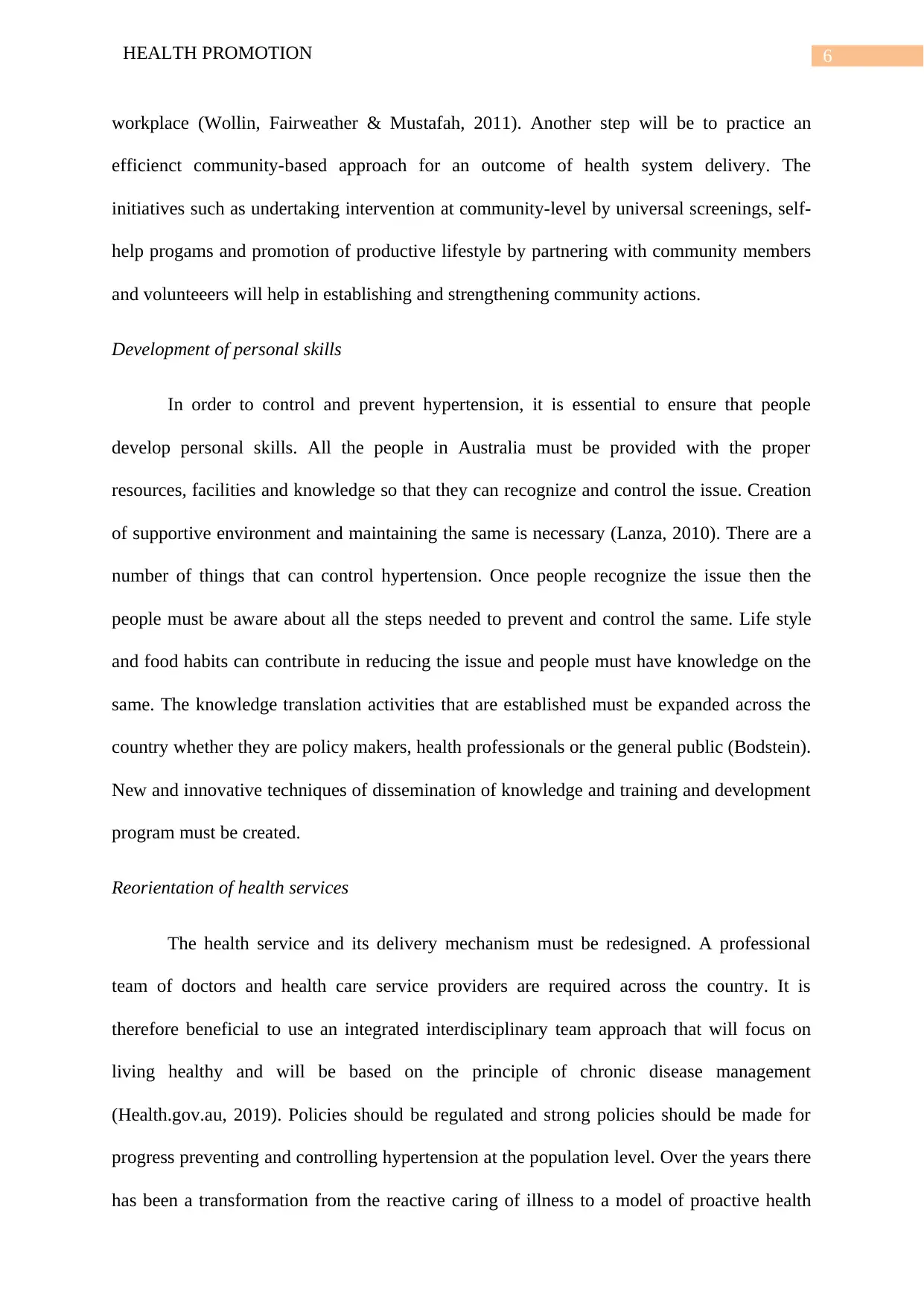
6HEALTH PROMOTION
workplace (Wollin, Fairweather & Mustafah, 2011). Another step will be to practice an
efficienct community-based approach for an outcome of health system delivery. The
initiatives such as undertaking intervention at community-level by universal screenings, self-
help progams and promotion of productive lifestyle by partnering with community members
and volunteeers will help in establishing and strengthening community actions.
Development of personal skills
In order to control and prevent hypertension, it is essential to ensure that people
develop personal skills. All the people in Australia must be provided with the proper
resources, facilities and knowledge so that they can recognize and control the issue. Creation
of supportive environment and maintaining the same is necessary (Lanza, 2010). There are a
number of things that can control hypertension. Once people recognize the issue then the
people must be aware about all the steps needed to prevent and control the same. Life style
and food habits can contribute in reducing the issue and people must have knowledge on the
same. The knowledge translation activities that are established must be expanded across the
country whether they are policy makers, health professionals or the general public (Bodstein).
New and innovative techniques of dissemination of knowledge and training and development
program must be created.
Reorientation of health services
The health service and its delivery mechanism must be redesigned. A professional
team of doctors and health care service providers are required across the country. It is
therefore beneficial to use an integrated interdisciplinary team approach that will focus on
living healthy and will be based on the principle of chronic disease management
(Health.gov.au, 2019). Policies should be regulated and strong policies should be made for
progress preventing and controlling hypertension at the population level. Over the years there
has been a transformation from the reactive caring of illness to a model of proactive health
workplace (Wollin, Fairweather & Mustafah, 2011). Another step will be to practice an
efficienct community-based approach for an outcome of health system delivery. The
initiatives such as undertaking intervention at community-level by universal screenings, self-
help progams and promotion of productive lifestyle by partnering with community members
and volunteeers will help in establishing and strengthening community actions.
Development of personal skills
In order to control and prevent hypertension, it is essential to ensure that people
develop personal skills. All the people in Australia must be provided with the proper
resources, facilities and knowledge so that they can recognize and control the issue. Creation
of supportive environment and maintaining the same is necessary (Lanza, 2010). There are a
number of things that can control hypertension. Once people recognize the issue then the
people must be aware about all the steps needed to prevent and control the same. Life style
and food habits can contribute in reducing the issue and people must have knowledge on the
same. The knowledge translation activities that are established must be expanded across the
country whether they are policy makers, health professionals or the general public (Bodstein).
New and innovative techniques of dissemination of knowledge and training and development
program must be created.
Reorientation of health services
The health service and its delivery mechanism must be redesigned. A professional
team of doctors and health care service providers are required across the country. It is
therefore beneficial to use an integrated interdisciplinary team approach that will focus on
living healthy and will be based on the principle of chronic disease management
(Health.gov.au, 2019). Policies should be regulated and strong policies should be made for
progress preventing and controlling hypertension at the population level. Over the years there
has been a transformation from the reactive caring of illness to a model of proactive health
Paraphrase This Document
Need a fresh take? Get an instant paraphrase of this document with our AI Paraphraser
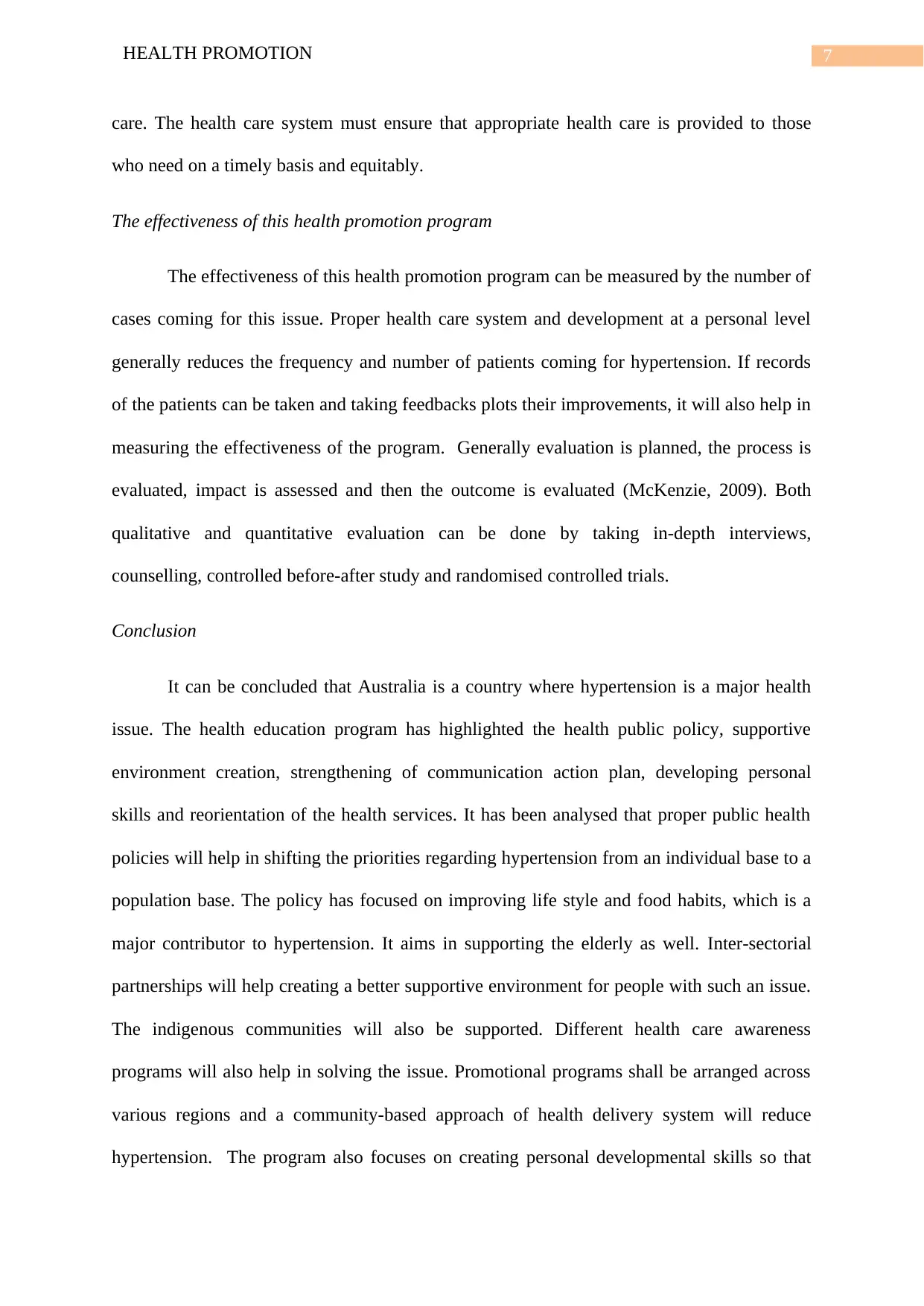
7HEALTH PROMOTION
care. The health care system must ensure that appropriate health care is provided to those
who need on a timely basis and equitably.
The effectiveness of this health promotion program
The effectiveness of this health promotion program can be measured by the number of
cases coming for this issue. Proper health care system and development at a personal level
generally reduces the frequency and number of patients coming for hypertension. If records
of the patients can be taken and taking feedbacks plots their improvements, it will also help in
measuring the effectiveness of the program. Generally evaluation is planned, the process is
evaluated, impact is assessed and then the outcome is evaluated (McKenzie, 2009). Both
qualitative and quantitative evaluation can be done by taking in-depth interviews,
counselling, controlled before-after study and randomised controlled trials.
Conclusion
It can be concluded that Australia is a country where hypertension is a major health
issue. The health education program has highlighted the health public policy, supportive
environment creation, strengthening of communication action plan, developing personal
skills and reorientation of the health services. It has been analysed that proper public health
policies will help in shifting the priorities regarding hypertension from an individual base to a
population base. The policy has focused on improving life style and food habits, which is a
major contributor to hypertension. It aims in supporting the elderly as well. Inter-sectorial
partnerships will help creating a better supportive environment for people with such an issue.
The indigenous communities will also be supported. Different health care awareness
programs will also help in solving the issue. Promotional programs shall be arranged across
various regions and a community-based approach of health delivery system will reduce
hypertension. The program also focuses on creating personal developmental skills so that
care. The health care system must ensure that appropriate health care is provided to those
who need on a timely basis and equitably.
The effectiveness of this health promotion program
The effectiveness of this health promotion program can be measured by the number of
cases coming for this issue. Proper health care system and development at a personal level
generally reduces the frequency and number of patients coming for hypertension. If records
of the patients can be taken and taking feedbacks plots their improvements, it will also help in
measuring the effectiveness of the program. Generally evaluation is planned, the process is
evaluated, impact is assessed and then the outcome is evaluated (McKenzie, 2009). Both
qualitative and quantitative evaluation can be done by taking in-depth interviews,
counselling, controlled before-after study and randomised controlled trials.
Conclusion
It can be concluded that Australia is a country where hypertension is a major health
issue. The health education program has highlighted the health public policy, supportive
environment creation, strengthening of communication action plan, developing personal
skills and reorientation of the health services. It has been analysed that proper public health
policies will help in shifting the priorities regarding hypertension from an individual base to a
population base. The policy has focused on improving life style and food habits, which is a
major contributor to hypertension. It aims in supporting the elderly as well. Inter-sectorial
partnerships will help creating a better supportive environment for people with such an issue.
The indigenous communities will also be supported. Different health care awareness
programs will also help in solving the issue. Promotional programs shall be arranged across
various regions and a community-based approach of health delivery system will reduce
hypertension. The program also focuses on creating personal developmental skills so that
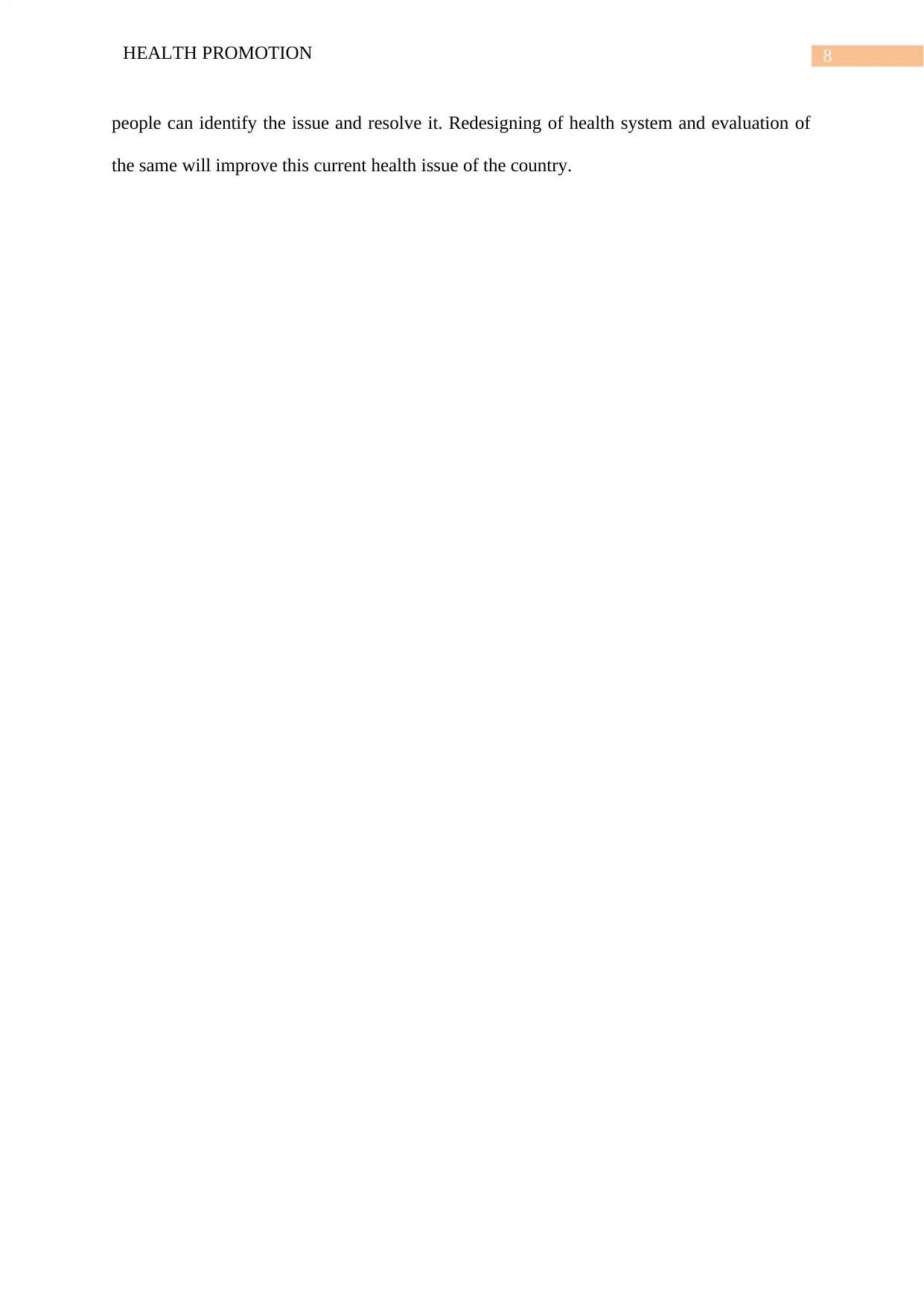
8HEALTH PROMOTION
people can identify the issue and resolve it. Redesigning of health system and evaluation of
the same will improve this current health issue of the country.
people can identify the issue and resolve it. Redesigning of health system and evaluation of
the same will improve this current health issue of the country.
⊘ This is a preview!⊘
Do you want full access?
Subscribe today to unlock all pages.

Trusted by 1+ million students worldwide
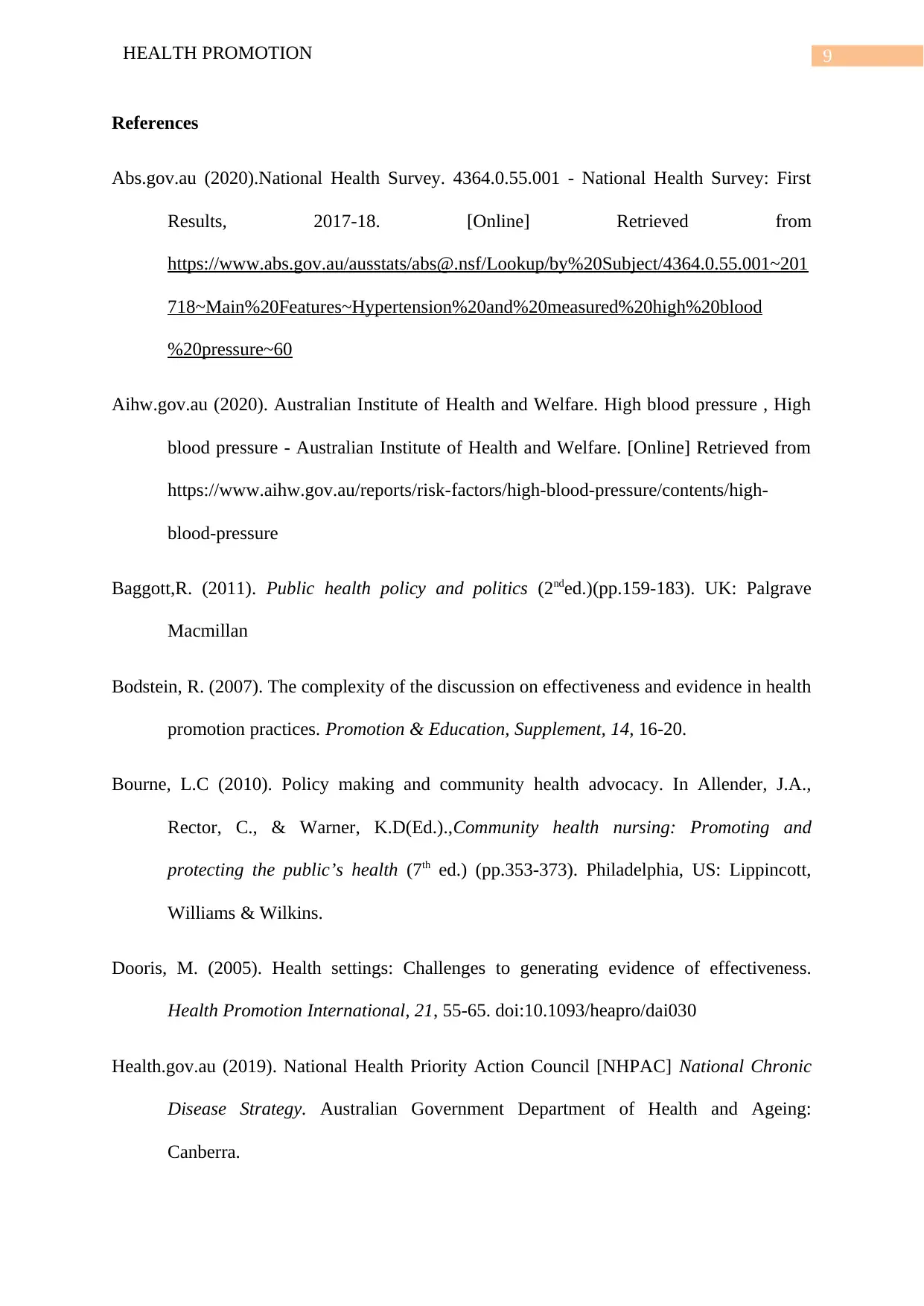
9HEALTH PROMOTION
References
Abs.gov.au (2020).National Health Survey. 4364.0.55.001 - National Health Survey: First
Results, 2017-18. [Online] Retrieved from
https://www.abs.gov.au/ausstats/abs@.nsf/Lookup/by%20Subject/4364.0.55.001~201
718~Main%20Features~Hypertension%20and%20measured%20high%20blood
%20pressure~60
Aihw.gov.au (2020). Australian Institute of Health and Welfare. High blood pressure , High
blood pressure - Australian Institute of Health and Welfare. [Online] Retrieved from
https://www.aihw.gov.au/reports/risk-factors/high-blood-pressure/contents/high-
blood-pressure
Baggott,R. (2011). Public health policy and politics (2nded.)(pp.159-183). UK: Palgrave
Macmillan
Bodstein, R. (2007). The complexity of the discussion on effectiveness and evidence in health
promotion practices. Promotion & Education, Supplement, 14, 16-20.
Bourne, L.C (2010). Policy making and community health advocacy. In Allender, J.A.,
Rector, C., & Warner, K.D(Ed.).,Community health nursing: Promoting and
protecting the public’s health (7th ed.) (pp.353-373). Philadelphia, US: Lippincott,
Williams & Wilkins.
Dooris, M. (2005). Health settings: Challenges to generating evidence of effectiveness.
Health Promotion International, 21, 55-65. doi:10.1093/heapro/dai030
Health.gov.au (2019). National Health Priority Action Council [NHPAC] National Chronic
Disease Strategy. Australian Government Department of Health and Ageing:
Canberra.
References
Abs.gov.au (2020).National Health Survey. 4364.0.55.001 - National Health Survey: First
Results, 2017-18. [Online] Retrieved from
https://www.abs.gov.au/ausstats/abs@.nsf/Lookup/by%20Subject/4364.0.55.001~201
718~Main%20Features~Hypertension%20and%20measured%20high%20blood
%20pressure~60
Aihw.gov.au (2020). Australian Institute of Health and Welfare. High blood pressure , High
blood pressure - Australian Institute of Health and Welfare. [Online] Retrieved from
https://www.aihw.gov.au/reports/risk-factors/high-blood-pressure/contents/high-
blood-pressure
Baggott,R. (2011). Public health policy and politics (2nded.)(pp.159-183). UK: Palgrave
Macmillan
Bodstein, R. (2007). The complexity of the discussion on effectiveness and evidence in health
promotion practices. Promotion & Education, Supplement, 14, 16-20.
Bourne, L.C (2010). Policy making and community health advocacy. In Allender, J.A.,
Rector, C., & Warner, K.D(Ed.).,Community health nursing: Promoting and
protecting the public’s health (7th ed.) (pp.353-373). Philadelphia, US: Lippincott,
Williams & Wilkins.
Dooris, M. (2005). Health settings: Challenges to generating evidence of effectiveness.
Health Promotion International, 21, 55-65. doi:10.1093/heapro/dai030
Health.gov.au (2019). National Health Priority Action Council [NHPAC] National Chronic
Disease Strategy. Australian Government Department of Health and Ageing:
Canberra.
Paraphrase This Document
Need a fresh take? Get an instant paraphrase of this document with our AI Paraphraser
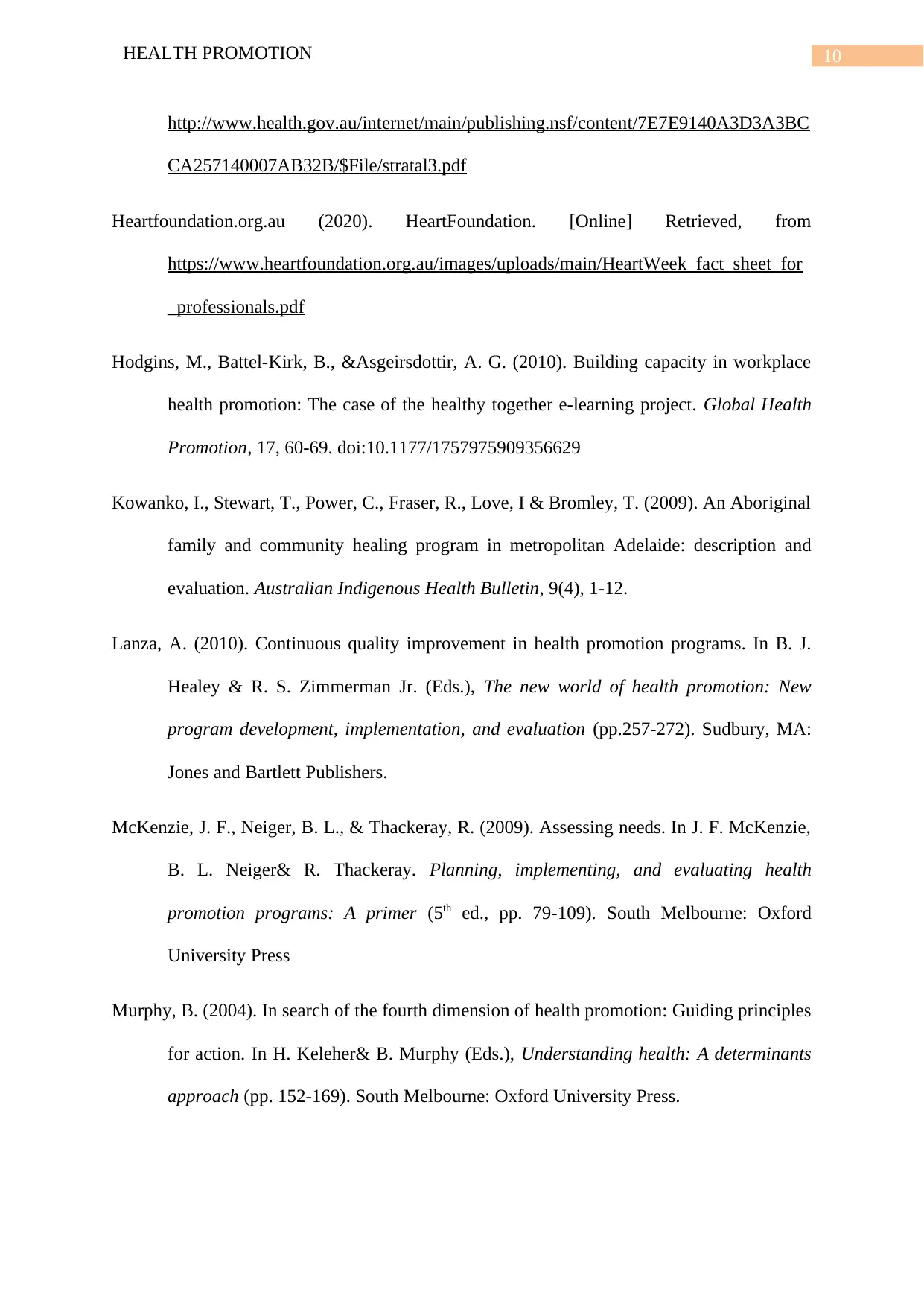
10HEALTH PROMOTION
http://www.health.gov.au/internet/main/publishing.nsf/content/7E7E9140A3D3A3BC
CA257140007AB32B/$File/stratal3.pdf
Heartfoundation.org.au (2020). HeartFoundation. [Online] Retrieved, from
https://www.heartfoundation.org.au/images/uploads/main/HeartWeek_fact_sheet_for
_professionals.pdf
Hodgins, M., Battel-Kirk, B., &Asgeirsdottir, A. G. (2010). Building capacity in workplace
health promotion: The case of the healthy together e-learning project. Global Health
Promotion, 17, 60-69. doi:10.1177/1757975909356629
Kowanko, I., Stewart, T., Power, C., Fraser, R., Love, I & Bromley, T. (2009). An Aboriginal
family and community healing program in metropolitan Adelaide: description and
evaluation. Australian Indigenous Health Bulletin, 9(4), 1-12.
Lanza, A. (2010). Continuous quality improvement in health promotion programs. In B. J.
Healey & R. S. Zimmerman Jr. (Eds.), The new world of health promotion: New
program development, implementation, and evaluation (pp.257-272). Sudbury, MA:
Jones and Bartlett Publishers.
McKenzie, J. F., Neiger, B. L., & Thackeray, R. (2009). Assessing needs. In J. F. McKenzie,
B. L. Neiger& R. Thackeray. Planning, implementing, and evaluating health
promotion programs: A primer (5th ed., pp. 79-109). South Melbourne: Oxford
University Press
Murphy, B. (2004). In search of the fourth dimension of health promotion: Guiding principles
for action. In H. Keleher& B. Murphy (Eds.), Understanding health: A determinants
approach (pp. 152-169). South Melbourne: Oxford University Press.
http://www.health.gov.au/internet/main/publishing.nsf/content/7E7E9140A3D3A3BC
CA257140007AB32B/$File/stratal3.pdf
Heartfoundation.org.au (2020). HeartFoundation. [Online] Retrieved, from
https://www.heartfoundation.org.au/images/uploads/main/HeartWeek_fact_sheet_for
_professionals.pdf
Hodgins, M., Battel-Kirk, B., &Asgeirsdottir, A. G. (2010). Building capacity in workplace
health promotion: The case of the healthy together e-learning project. Global Health
Promotion, 17, 60-69. doi:10.1177/1757975909356629
Kowanko, I., Stewart, T., Power, C., Fraser, R., Love, I & Bromley, T. (2009). An Aboriginal
family and community healing program in metropolitan Adelaide: description and
evaluation. Australian Indigenous Health Bulletin, 9(4), 1-12.
Lanza, A. (2010). Continuous quality improvement in health promotion programs. In B. J.
Healey & R. S. Zimmerman Jr. (Eds.), The new world of health promotion: New
program development, implementation, and evaluation (pp.257-272). Sudbury, MA:
Jones and Bartlett Publishers.
McKenzie, J. F., Neiger, B. L., & Thackeray, R. (2009). Assessing needs. In J. F. McKenzie,
B. L. Neiger& R. Thackeray. Planning, implementing, and evaluating health
promotion programs: A primer (5th ed., pp. 79-109). South Melbourne: Oxford
University Press
Murphy, B. (2004). In search of the fourth dimension of health promotion: Guiding principles
for action. In H. Keleher& B. Murphy (Eds.), Understanding health: A determinants
approach (pp. 152-169). South Melbourne: Oxford University Press.

11HEALTH PROMOTION
Talbot, L., & Verrinder, G. (2010). Health promotion in context: Primary health care and the
new public health movement. In Promoting health: A primary health care approach
(4th ed., pp. 1-34). Sydney: Churchill Livingstone, Elsevier.
WHO.int (2020). World Health Organisation. Promoting health and development: Closing
the implementation gap, 7th Global conference on health promotion. [Online]
Retrieved on http://www.who.int/healthpromotion/conferences/7gchp/en/index.html
Wollin, J., Fairweather, C., &Mustafah, N. (2011).Health education and health promotion. In
Kralik& van Loon (Eds.),Community nursingin Australia (2nd ed.)(pp. 389-427).
Milton, Qld:John Wiley and Sons.
Talbot, L., & Verrinder, G. (2010). Health promotion in context: Primary health care and the
new public health movement. In Promoting health: A primary health care approach
(4th ed., pp. 1-34). Sydney: Churchill Livingstone, Elsevier.
WHO.int (2020). World Health Organisation. Promoting health and development: Closing
the implementation gap, 7th Global conference on health promotion. [Online]
Retrieved on http://www.who.int/healthpromotion/conferences/7gchp/en/index.html
Wollin, J., Fairweather, C., &Mustafah, N. (2011).Health education and health promotion. In
Kralik& van Loon (Eds.),Community nursingin Australia (2nd ed.)(pp. 389-427).
Milton, Qld:John Wiley and Sons.
⊘ This is a preview!⊘
Do you want full access?
Subscribe today to unlock all pages.

Trusted by 1+ million students worldwide
1 out of 12
Related Documents
Your All-in-One AI-Powered Toolkit for Academic Success.
+13062052269
info@desklib.com
Available 24*7 on WhatsApp / Email
![[object Object]](/_next/static/media/star-bottom.7253800d.svg)
Unlock your academic potential
Copyright © 2020–2025 A2Z Services. All Rights Reserved. Developed and managed by ZUCOL.





